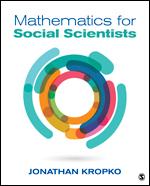Welcome to the Companion Website
This site is intended to enhance your use of Mathematics for Social Scientists, by Jonathan Kropko. The solutions to practice problems on this website are geared toward maximizing your understanding of the material.
To Students: you will find here the answers to every exercise that appears at the end of one of the chapters of Mathematics for Social Scientists. Remember, the social sciences have become very quantitative. If you are able to perform the underlying math, you will feel confident using quantitative methods later. And that feeling will put you far ahead of many of your peers in the social sciences. Don't cheat yourself out of that advantage by using this guide to cut corners.
If you have worked on an exercise, thought about the problems it presents, and given it real effort, then this guide can help you to evaluate your work. The answers here do not simply list the answer. They work through the entire problem from beginning to end. It is my hope that this guide can be just as effective at teaching as the main text. Be careful reading through problems in the later chapters, however. For the sake of space, I sometimes skip describing the steps for techniques that are covered in an earlier chapter. I might not take the time to explain a square root in an exercise from the chapter on integrals. If you find that I've skipped over describing an important step, check to see whether it's covered in an earlier chapter.
There are often many different ways to solve the same problem, so copying the particular steps outlined here again and again will be transparent to your instructor, who also has a copy of this answer guide. If you try the problem and find yourself stuck, then give yourself some time to think about a solution for yourself before referring to this guide. You will find the answer more satisfying if you do.
To Instructors: please be aware that your students may be able to acquire a copy of this guide and take steps to make it less easy for a student to copy the steps exactly from this guide. You might perhaps slightly alter the problems. You might want to discuss this guide with the students at the beginning of the course to let them know you have this guide and that—since there are often many ways to get to the same answer—you will be able to identify work that copies from this guide.
It is important that, before assigning exercises from this book, you read through the answer guide to get a sense of how much work and what level of work each exercise entails. Some of the exercises are simply stated but deceptively complex.
To Everyone: it is very likely that I've made errors in this guide that I've been unable to catch before it became available to you. If you identify an error, I would be grateful if you contacted the publisher at supplements@sagepub.com.
I hope that, no matter what your role in a math class, you find this guide instructive and useful, and that it helps you to become a more confident user of applied mathematics in the social sciences. Thank you for reading Mathematics for Social Scientists and this guide.
Acknowledgments
We gratefully acknowledge Jonathan Kropko for writing an excellent text and creating the materials on this site.

